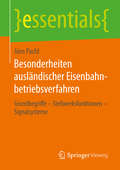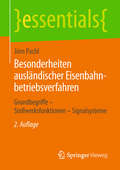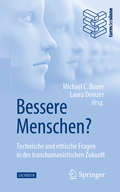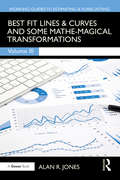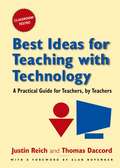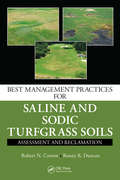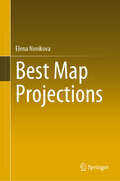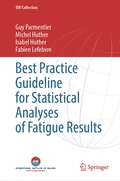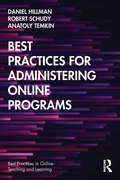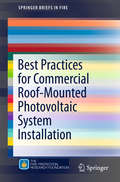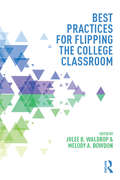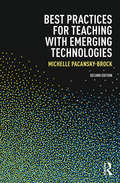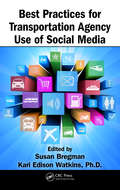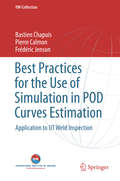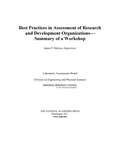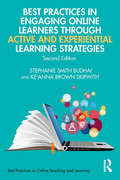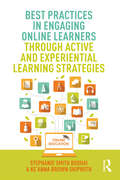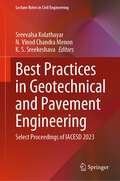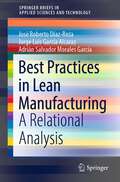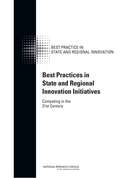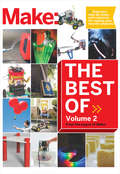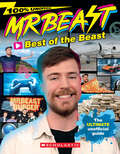- Table View
- List View
Besonderheiten ausländischer Eisenbahnbetriebsverfahren: Grundbegriffe – Stellwerksfunktionen – Signalsysteme (essentials)
by Jörn PachlIn diesem essential wendet sich Jörn Pachl an Fachleute des deutschen Bahnbetriebs, die sich über charakteristische Unterschiede ausländischer Betriebsverfahren gegenüber den im deutschen Bahnwesen üblichen Grundsätzen informieren möchten. Obwohl die technischen Grundzüge von Eisenbahnen überall gleich sind, zeigt der Autor, dass die Betriebsverfahren in erheblichem Maß differieren. Die Unterschiede liegen nicht im Detail, sondern betreffen selbst grundlegende Definitionen im System Bahn. Da im Rahmen dieser kompakten Darstellung keine Detailbeschreibungen einzelner Länder möglich sind, konzentriert sich der Autor auf Bereiche mit besonders relevanten Unterschieden zum deutschen Bahnbetrieb, die an typischen Beispielen demonstriert werden.
Besonderheiten ausländischer Eisenbahnbetriebsverfahren: Grundbegriffe – Stellwerksfunktionen – Signalsysteme (essentials)
by Jörn PachlIn diesem essential wendet sich Jörn Pachl an Fachleute des deutschen Bahnbetriebs, die sich über charakteristische Unterschiede ausländischer Betriebsverfahren gegenüber den im deutschen Bahnwesen üblichen Grundsätzen informieren möchten. Obwohl die technischen Grundzüge von Eisenbahnen überall gleich sind, zeigt der Autor, dass die Betriebsverfahren in erheblichem Maß differieren. Die Unterschiede liegen nicht im Detail, sondern betreffen selbst grundlegende Definitionen im System Bahn. Da im Rahmen dieser kompakten Darstellung keine Detailbeschreibungen einzelner Länder möglich sind, konzentriert sich der Autor auf Bereiche mit besonders relevanten Unterschieden zum deutschen Bahnbetrieb, die an typischen Beispielen demonstriert werden. Neben einigen kleineren Ergänzungen und Präzisierungen wurde in der zweiten Auflage die Anschaulichkeit der Abbildungen durch Übergang zu farbigen Darstellungen deutlich erhöht.
Bessere Menschen? Technische und ethische Fragen in der transhumanistischen Zukunft
by Michael C. Bauer Laura DeinzerBessere Menschen? Der Mensch hat schon seit jeher Wege gefunden, um sich selbst zu verbessern. Er erfand einfache medizinische und technische Hilfsmittel, wie die Brille oder die Zahnspange, und auch kompliziertere, wie fühlende Prothesen und Gehirnimplantate. Der technologische und medizinische Fortschritt bringt tiefgreifende Möglichkeiten der Erweiterung des Menschen mit sich. Visionen von Cyborgs und einem „Upgrade“ des Menschen lösen aber nicht ausschließlich Euphorie, sondern vielfach auch Bedenken aus. Welche technischen, aber vor allem auch welche ethischen Herausforderungen die Zukunft mit sich bringt, steht im Mittelpunkt dieses Buches. Beiträge verschiedener Fachgebiete von Psychologie und Medizin, über Philosophie und Soziologie bis zu Gender Studies beleuchten, wie sich das Verhältnis von Mensch und Maschine verändern wird, wie sich die Medizintechnik an der Schnittstelle von „Enhancement“ und Therapie bewegt und wie die Gesellschaft auf die tiefgreifenden Veränderungen im Technologiezeitalter reagieren kann.
Best Available and Safest Technologies for Offshore Oil and Gas Operations: Options for Implementation
by National Research Council National Academy of Engineering Committee on Options for Implementing the Requirement of Best Available Safest Technologies for Offshore Oil Gas Operations Marine BoardBest Available and Safest Technologies for Offshore Oil and Gas Operations: Options for Implementation explores a range of options for improving the implementation of the U.S. Department of the Interior's congressional mandate to require the use of best available and safety technologies in offshore oil and gas operations. In the Outer Continental Shelf Lands Act, Congress directs the Secretary of the Interior to regulate oil and gas operations in federal waters. The act mandates that the Secretary “shall require, on all new drilling and production operations and, wherever practicable, on existing operations, the use of the best available and safest technologies which the Secretary determines to be economically feasible, wherever failure of equipment would have a significant effect on safety, health, or the environment, except where the Secretary determines that the incremental benefits are clearly insufficient to justify the incremental costs of utilizing such technologies.†This report, which was requested by Department of the Interior's Bureau of Safety and Environmental Enforcement (BSEE), also reviews options and issues that BSEE is already considering to improve implementation of the best available and safest technologies requirement.
Best Fit Lines & Curves: And Some Mathe-Magical Transformations (Working Guides to Estimating & Forecasting #3)
by Alan R. JonesBest Fit Lines and Curves, and Some Mathe-Magical Transformations (Volume III of the Working Guides to Estimating & Forecasting series) concentrates on techniques for finding the Best Fit Line or Curve to some historical data allowing us to interpolate or extrapolate the implied relationship that will underpin our prediction. A range of simple ‘Moving Measures’ are suggested to smooth the underlying trend and quantify the degree of noise or scatter around that trend. The advantages and disadvantages are discussed and a simple way to offset the latent disadvantage of most Moving Measure Techniques is provided. Simple Linear Regression Analysis, a more formal numerical technique that calculates the line of best fit subject to defined ‘goodness of fit’ criteria. Microsoft Excel is used to demonstrate how to decide whether the line of best fit is a good fit, or just a solution in search of some data. These principles are then extended to cover multiple cost drivers, and how we can use them to quantify 3-Point Estimates. With a deft sleight of hand, certain commonly occurring families of non-linear relationships can be transformed mathe-magically into linear formats, allowing us to exploit the powers of Regression Analysis to find the Best Fit Curves. The concludes with an exploration of the ups and downs of seasonal data (Time Series Analysis). Supported by a wealth of figures and tables, this is a valuable resource for estimators, engineers, accountants, project risk specialists as well as students of cost engineering.
Best Ideas for Teaching with Technology: A Practical Guide for Teachers, by Teachers
by Justin Reich Tom DaccordThis practical, how-to guide makes it easy for teachers to incorporate the latest technology in their classes. Employing an informal workshop approach, the book avoids technical jargon and pays special attention to the needs of teachers who are expanding the use of computers in their classrooms. The authors focus on what teachers do and how they can do it better, and provide a wide variety of proven tools, tips, and methods for enhancing these activities with technology."Best Ideas for Teaching with Technology" provides extensively illustrated tutorials for a wide variety of software, online tools, and teaching techniques. It covers everything from lesson plans, to time management, how to show animation, blogging, podcasts, laptop strategies, and much, much more. In addition, periodic updates to the text will be available on the authors' website.
Best Management Practices for Saline and Sodic Turfgrass Soils: Assessment and Reclamation
by Robert N. Carrow Ronny R. DuncanThe complex issues involved in the management of saline and sodic turfgrass soils are enough to perplex even the most experienced site manager- there is no "silver bullet" amendment, treatment, or grass for salinity management. Best Management Practices for Saline and Sodic Turfgrass Soils: Assessment and Reclamation presents comprehensive scientif
Best Map Projections
by Elena NovikovaThis book presents the most condensed information about the theory of distortion theory developed by N.A. Tissot. It considers some of the issues of this theory to finding the best projections. Various criteria for ideal projections are analyzed. In finding an ideal projection using the Airy criterion for an arbitrary mapping region is solved by the variational method using the Euler–Ostrogradsky system of equations under natural boundary conditions. The same method is applied to a set of projections in which the sum of the extremal scale factors is equal to 2. It is shown that for these projections, the area distortions are quantities of the second order of smallness, while the linear distortions are quantities of the first order of smallness. The problem of finding the best projections using the Chebyshev criterion has been studied. Airy, Postel, Gauss–Kruger, and Markov projections are considered in detail.
Best Practice Guideline for Statistical Analyses of Fatigue Results (IIW Collection)
by Guy Parmentier Michel Huther Isabel Huther Fabien LefebvreThis book provides a comprehensive guidance for the use of sound statistical methods and for the evaluation of fatigue data of welded components and structures obtained under constant amplitude loading and used to produce S-N curves. Recommendations for analyzing fatigue data are available, although they do not deal with all the statistical treatments that may be required to utilize fatigue test results, and none of them offers specific guidelines for analyzing fatigue data obtained from tests on welded specimens. For an easy use, working sheets are provided to assist in the proper statistical assessment of experimental fatigue data concerning practical problems giving the procedure and a numerical application as illustration.
Best Practices for Administering Online Programs (Best Practices in Online Teaching and Learning)
by Daniel Hillman Robert Schudy Anatoly TemkinBest Practices for Administering Online Programs is a practical volume for university teams seeking to manage effective online programs. Defining, designing, implementing, and updating online courses is a highly collaborative effort, particularly with limited resources and expanding student enrollment. This book unites the efforts of program directors, supervisors, department chairs, participating faculty, instructional designers, IT specialists, and support staff toward a common goal: affordable, accessible, and scalable online learning. Readers will find guidelines for fostering quality, faculty skills, academic integrity, learning objectives, course improvement, and more.
Best Practices for Commercial Roof-Mounted Photovoltaic System Installation (SpringerBriefs in Fire)
by James A. Milke Rosalie Wills Sara Royle Kristin SterankaThis SpringerBrief presents information on a wide variety of hazards and the damage potential caused by installation of a photovoltaic (PV) system. The current installation practices for PV systems on roofs create electrical, fire, structural, and weather-related hazards that do not comply to current codes, standards and guidance documents. Potential dangers include structural loading, wind loads, hail, snow, debris accumulation, seismic hazards, firefighting hazards, and electrical hazards. Despite the increased popularity of PV systems after the environmental movement, research shows that the costs of installing PV systems outweigh the benefits. Hazards of PV systems on roofs have caused several incidents in the United States; the most notable in Bakersfield, California, and Mount Holly, North Carolina. Designed for fire engineers and professionals, Best Practices for Commercial Roof-Mounted Photovoltaic System Installation offers recommendations to set up PV systems safely and sustainably.
Best Practices for Environmental Health: Environmental Pollution, Protection, Quality and Sustainability (Best Practices for Public Health)
by Herman KorenIn a present where there are countless opportunities for the spread of exotic diseases, the expansion and creation of far more illness in our global population through globalization and rapid transportation, and the contamination of water, air and land, we find ourselves accountable. In this day and age we are confronted by global warming, Ebola, the Zika virus, lead in our water supply, enormous problems of infrastructure including aging sewer lines, water lines, electrical grids, roads and bridges, and the list goes on and on. Best Practices for Environmental Health: Environmental Pollution, Protection, Quality and Sustainability is a one source major response to all of the environmental issues that affect global health and the worldwide protection and preservation of the natural environment. It compiles broad-based and comprehensive coverage of environmental topics, broken down by specialized fields. Topics range from children’s environmental health to food protection and technology, water and waste systems, infection control, bioterrorism and pandemic health emergencies, and HAZMAT. Plus, it includes an overview of the current state of the profession and sections on programmatic techniques. This book helps solve the problems of disease and injury by presenting expert, evidence-based best practices. This first of the kind handbook is essential reading for all environmental and public health undergraduate students, as well as a fantastic overview for professionals in all environmental health, pollution and protection areas.
Best Practices for Flipping the College Classroom (Best Practices in Online Teaching and Learning)
by Julee B. Waldrop Melody A. BowdonBest Practices for Flipping the College Classroom provides a comprehensive overview and systematic assessment of the flipped classroom methodology in higher education. The book: Reviews various pedagogical theories that inform flipped classroom practice and provides a brief history from its inception in K–12 to its implementation in higher education. Offers well-developed and instructive case studies chronicling the implementation of flipped strategies across a broad spectrum of academic disciplines, physical environments, and student populations. Provides insights and suggestions to instructors in higher education for the implementation of flipped strategies in their own courses by offering reflections on learning outcomes and student success in flipped classrooms compared with those employing more traditional models and by describing relevant technologies. Discusses observations and analyses of student perceptions of flipping the classroom as well as student practices and behaviors particular to flipped classroom models. Illuminates several research models and approaches for use and modification by teacher-scholars interested in building on this research on their own campuses. The evidence presented on the flipped classroom methodology by its supporters and detractors at all levels has thus far been almost entirely anecdotal or otherwise unreliable. Best Practices for Flipping the College Classroom is the first book to provide faculty members nuanced qualitative and quantitative evidence that both supports and challenges the value of flipping the college classroom.
Best Practices for Teaching Science: What Award-Winning Classroom Teachers Do
by Randi StoneLet Randi Stone and her award-winning teachers demonstrate tried-and-tested best practices for teaching science in diverse elementary, middle, and high school classrooms. Linked to companion volumes for teaching writing and mathematics, this resource for new and veteran educators helps build student confidence and success through innovative approaches for raising student achievement in science, such as: Expeditionary learning, technology and music, and independent research study Model lessons in environmental studies and real-world science Inquiry-based strategies using robotics, rockets, straw-bale greenhouses, "Project Dracula," "Making Microbes Fun," and more! With engaging activities weaving through science fact and fiction to lead learners on intriguing journeys of discovery, this guide is sure to fascinate and inspire both you and your students!
Best Practices for Teaching with Emerging Technologies (Best Practices in Online Teaching and Learning)
by Michelle Pacansky-BrockAs social media and Web 2.0 technologies continue to transform the learning trends and preferences of students, educators need to understand the applicability of these new tools in all types of learning environments. The second edition of Best Practices for Teaching with Emerging Technologies provides new and experienced instructors with practical examples of how low-cost and free technologies can be used to support student learning as well as best practices for integrating web-based tools into a course management system and managing student privacy in a Web 2.0 environment. "Showcase" spotlights throughout exemplify how the tools described in the book are already being used effectively in educational settings. This thoroughly revised second edition includes: a new chapter that explores how and why faculty are using the public web and open educational resources in place of a learning management system (LMS) and an expensive textbook additional tips and showcases in every chapter that illustrate faculty use of particular technologies the inclusion of new tools to replace technologies that no longer exist a revamped website featuring expanded online resources. This practical, easy-to-use guide will serve the needs of educators seeking to refresh or transform their instruction. Readers will be rewarded with an ample yet manageable collection of proven emerging technologies that can be leveraged for generating content, enhancing communications with and between students, and cultivating participatory, student-centered learning activities.
Best Practices for Transportation Agency Use of Social Media
by Susan Bregman Kari Edison WatkinsTimely updates, increased citizen engagement, and more effective marketing are just a few of the reasons transportation agencies have already started to adopt social media networking tools. Best Practices for Transportation Agency Use of Social Media offers real-world advice for planning and implementing social media from leading government practit
Best Practices for the Use of Simulation in POD Curves Estimation: Application to UT Weld Inspection (IIW Collection)
by Bastien Chapuis Pierre Calmon Frédéric JensonThis book provides best-practice guidance and practical recommendations on the use of numerical simulation for probability of detection (POD) curve estimation in the study of non-destructive testing reliability. It focuses on ultrasonic testing (UT) weld inspection but many of the principles can be applied to a broader range of techniques and situations. The first part lists and briefly describes the principal documents that establish the recommended statistical framework adapted for POD curve estimation. It also presents the most important initiatives on the model assisted probability of detection (MAPOD) approach in recent years. The second part provides details of the advantages and limitations of the simulation in this context. The third part then describes the prerequisites for the use of simulation (validation of the software, expertise of the user), and the fourth and main part offers the methodology and guidance as well as possible applications for using POD curves determined using simulation.
Best Practices in Assessment of Research and Development Organizations
by National Research Council Division on Engineering and Physical Sciences Laboratory Assessments BoardThe National Institute of Standards and Technology (NIST)--recognizing that information and insights gained through continual examination of practices for organizational assessment are useful for decision makers at organizations across the deferral, industrial, academic, and national laboratory sectors-recently requested that the National Research Council (NRC) organize a panel to review best practices in assessment of research and development (R&D) organizations. In response, the NRC established the Panel for Review of Best Practices in Assessment of Research and Development Organizations. The panel was charged to consider means of assessing the following in a manner that satisfies the requirements of NIST to perform effective assessments but also identifies assessment methods that can be applied selectively to other R&D organizations. These methods include: technical merit and quality of the science and engineering work, the adequacy of the resources available to support high-quality work, the effectiveness of the agency's delivery of the services and products required to fulfill its goals, the degree to which the agency's current and planned R&D portfolio supports its mission, as well as the agency's flexibility to respond to changing economic, political, social and technological contexts. As one means of data gathering, among others that the panel is performing toward development of a final report of its findings, the panel organized a planning committee for a workshop on best practices in assessment of R&D organizations. Best Practices in Assessment of Research and Development Organizations: Summary of a Workshop reviews the workshop conducted at the Keck Center of the National Academies in Washington, D.C., on March 19, 2012.
Best Practices in Engaging Online Learners Through Active and Experiential Learning Strategies (Best Practices in Online Teaching and Learning)
by Stephanie Smith Budhai Ke'Anna Brown SkipwithBest Practices in Engaging Online Learners Through Active and Experiential Learning Strategies, Second Edition, is a practical guide for all instructors, instructional designers, and online learning administrators designing, developing, teaching, and leading online, hybrid and blended learning courses and programs, who seek to provide supportive, engaging, and interactive learner experiences. This book explores the integration of active and experiential learning approaches and activities including simulations, gamification, social media integration, project-based learning, scenario-based learning, virtual tours, and online micro-credentialing as they relate to the development of authentic skill-building, communication, problem-solving, and critical-thinking skills in learners. New and emerging learning technologies of virtual and augmented reality along with artificial intelligence are included in this updated edition with examples of how instructors can actively use them in online courses to engage learners in experiential experiences. Readers will find guidelines for the development of participatory and peer-learning, competency-based learning, field-based experiences, clinical experiences, and service-learning opportunities in the online classroom. In addition, the authors provide effective learning strategies, discipline-specific examples, templates, and additional resources that align learner engagement with assessment practices and course outcomes.
Best Practices in Engaging Online Learners Through Active and Experiential Learning Strategies (Best Practices in Online Teaching and Learning)
by Stephanie Smith Budhai Ke'Anna SkipwithBest Practices in Engaging Online Learners Through Active and Experiential Learning Strategies is a practical guide for all instructors and instructional designers working in online or blended learning environments who want to provide a supportive, engaging, and interactive learner experience. This book explores the integration of active and experiential learning approaches and activities including gamification, social media integration, and project- and scenario-based learning, as they relate to the development of authentic skill-building, communication, problem-solving, and critical-thinking skills in learners. Readers will find guidelines for the development of participatory peer-learning, cooperative education, and service learning opportunities in the online classroom. In addition, the authors provide effective learning strategies, resources, and tools that align learner engagement with course outcomes.
Best Practices in Geotechnical and Pavement Engineering: Select Proceedings of IACESD 2023 (Lecture Notes in Civil Engineering #449)
by Sreevalsa Kolathayar N. Vinod Chandra Menon K. S. SreekeshavaThis book presents select proceedings of the International Conference on Interdisciplinary Approaches in Civil Engineering for Sustainable Development (IACESD 2023). The topics covered include emerging practices in geotechnical engineering and pavement, innovative approaches, and technologies to enhance the durability, sustainability, and performance of infrastructure, geosynthetics, geotechnical monitoring systems, and ground improvement techniques to address soil stability, settlement, and liquefaction issues. This book is useful for researchers and professionals’ geotechnical engineering.
Best Practices in Lean Manufacturing: A Relational Analysis (SpringerBriefs in Applied Sciences and Technology)
by Jorge Luis García Alcaraz José Roberto Díaz-Reza Adrián Salvador Morales GarcíaThis book reports four structural equation models (SEM) for quantifying the relationship between the most important lean manufacturing (LM) practices applied to the manufacturing industry. The SEMs are evaluated using 220 responses to a survey applied to manufacturing companies applying LM principles in the production system and are related to: distribution and maintenance, production process and quality system, supply chain and quality, and an integrator model. The findings identify the most important activities for every LM practices and how they are related. These relationship’ values will help administrators, managers, engineers to focus their efforts on these most important activities, facilitating the decision-making process.
Best Practices in State and Regional Innovation Initiatives
by Charles W. WessnerMost of the policy discussion about stimulating innovation has focused on the federal level. This study focuses on the significant activity at the state level, with the goal of improving the public's understanding of key policy strategies and exemplary practices. Based on a series of workshops and conferences that brought together policymakers along with leaders of industry and academia in a select number of states, the study highlights a rich variety of policy initiatives underway at the state and regional level to foster knowledge based growth and employment. Perhaps what distinguishes this effort at the state level is most of all the high degree of pragmatism. Operating out of necessity, innovation policies at the state level often involve taking advantage of existing resources and recombining them in new ways, forging innovative partnerships among universities, industry and government organizations, growing the skill base, and investing in the infrastructure to develop new technologies and new industries. Many of these initiatives are being guided by leaders from the private sector and universities. The objective of Best Practices in State and Regional Innovation Initiatives: Competing in the 21st Century is not to do an empirical review of the inputs and outputs of various state programs. Nor is it to evaluate which programs are superior. Indeed, some of the notable successes, such as the Albany nanotechnology cluster, represent a leap of leadership, investment, and sustained commitment that has had remarkable results in an industry that is actively pursued by many countries. The study's goal is to illustrate the approaches taken by a variety of highly diverse states as they confront the increasing challenges of global competition for the industries and jobs of today and tomorrow.
Best of Make: 65 Projects and Skill Builders from the Pages of Make: (Volume #2)
by The Editors of Make:After ten years, Make: has become one of most celebrated magazines to hit the newsstands, and certainly one of the hottest reads. If you're just catching on to the Maker Movement and wonder what you've missed, this book contains the best projects and articles from the magazine. Find out what keeps Makers coming back to Make: with this assortment of DIY projects and articles selected by Make:'s editors. Learn to:Outfit your workshop and make some must-have toolsBuild electronic projects from actuators to antennaeMake things with Arduino and Raspberry PiCreate drones and robotsBuild noisemaking projects and musical instrumentsAugment your photo and video capabilitiesMake your own food, soap, ink, and more
Best of the Beast! The Mr. Beast Unofficial Guide
by ScholasticFind out everything there is to know about Mr. Beast, the undisputed king of the internet! Full of photos, interviews, and more! 100% unofficial!If you've ever wondered how the much-loved megastar Mr. Beast became one of the BIGGEST and most popular YouTubers on the planet, then this is the book for you!Packed with fantastic facts, and insider info, this book has everything you need to know about the digital superstar!
